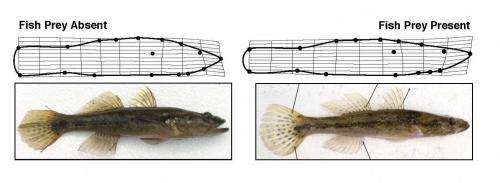Usual prey gone, a fish survives by changing predictably

A species of fish that normally eats smaller fish changes in predictable ways when isolated from its prey, research led by a Case Western Reserve University biologist found.
Without the Bahamas mosquitofish to eat, bigmouth sleepers slide down the food chain and survive on insects, snails and crustaceans—small invertebrates the mosquitofish normally eats.
And, in so doing, sleepers' behaviors, ratio of males to females and physical appearance change, too.
"One of the big questions in evolutionary biology is how predictable is change," said Ryan Martin, an assistant professor of biology at Case Western Reserve and lead author of the study. "In this case, we can predict ecological and phenotypic differentiation quite accurately."
"Potentially, evolution is occurring in a predictable way," Martin said. "But we will need to do more testing to know for sure."
Martin worked with R. Brian Langerhans, assistant professor of biological sciences at North Carolina State University, and Matthew D. McGee, a PhD student in population biology at University of California at Davis. Their findings are published in the March issue of Biological Journal of the Linnean Society.
Eventually, biologists hope to anticipate the consequences of urbanization, suburban sprawl, climate change, human-mediated travel that brings species to new habitats, and natural factors that are rapidly changing the world's environment, Martin said. Here, the researchers looked to nature for a relatively simple natural ecosystem to test their ability to predict how a species responds to a major change in their food resources over the timespan of several thousand years.
The scientists took advantage of the "natural laboratory" created by deep blue holes in the Bahamas. The holes are caves filled with seawater and topped by a layer of freshwater. Many are isolated and some harbor relatively simple communities, including fish species inhabiting the upper freshwater areas.
In earlier work, Langerhans studied the changes in Bahamas mosquitofish, Gambusia hubbsi that live in blue holes with and without bigmouth sleepers, Gobiomorus dormitor.
After finding two blue holes that had only sleepers, this group predicted many changes that were likely to occur if the sleepers were isolated from their mosquitofish prey. They then began to study the animals. Genetic testing indicated that some of the populations had been isolated from one another for thousands of years.
Of the 30 changes the researchers predicted, they found significant evidence for 22. The remaining factors did not show changes—no measured factor changed in a manner not predicted by the scientists. Among the most striking:
- An increased ratio of males to females. The absence of energy provided by prey fish likely leads to insufficient calories females need to develop and survive during reproductive periods.
- Lacking fish, sleepers use more shallow water, where they feed on a greater range of species, with individuals specializing on particular prey within the range.
- Sleepers that live with (and eat) fish have more elongate bodies with their greatest body depth shifted toward their tail to provide quicker acceleration, and have larger mouths that open wide to more effectively suck in evading fish prey. Sleepers living without other fish that eat invertebrates have deeper heads with a small mouth that allows them to produce a narrower but much more powerful suction to capture small prey.
Discover the latest in science, tech, and space with over 100,000 subscribers who rely on Phys.org for daily insights. Sign up for our free newsletter and get updates on breakthroughs, innovations, and research that matter—daily or weekly.
The physical differences between fish hunters and invertebrate hunters "mirror a pattern seen throughout many fishes of the world," Martin said. "While the pattern is well documented across distantly related fish species that feed on different prey, we found that significant changes can occur over much shorter timescales."
The researchers are seeking funding to continue their studies. To learn if the fish are evolving into new species they want to test whether sleepers that live with (and eat) fish are less likely to successfully breed with Sleepers isolated in blue holes without other fish.
The researchers also want to perform what's called a "common garden experiment," in which they bring bigmouth sleepers from their varying blue holes into the lab, where they are raised under common conditions, Martin said.
"That will enable us to see if the differences remain or go away," he said. "If they go away, then we know they are temporary environmental adaptations."
In the lab, they would also be able to test whether the bigmouth sleepers and mosquitofish are co-evolving—that is, whether sleepers are becoming better predators at the same time mosquitofish are becoming more successful at evading them.
More information: The paper can be found at: http://onlinelibrary.wiley.com/doi/10.1111/bij.12449/abstract.
Provided by Case Western Reserve University





















